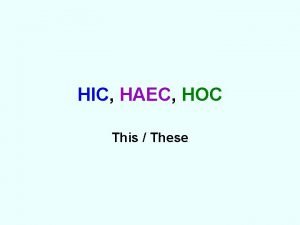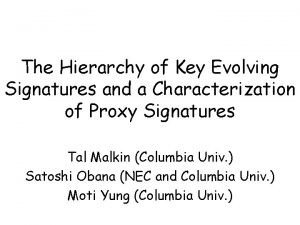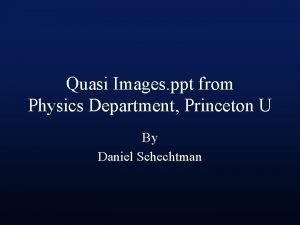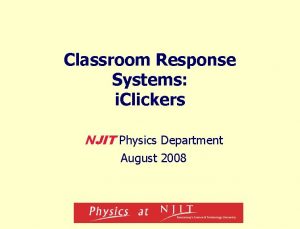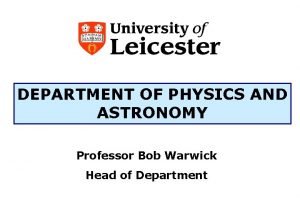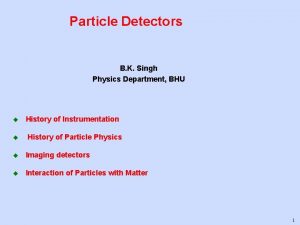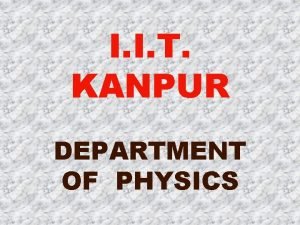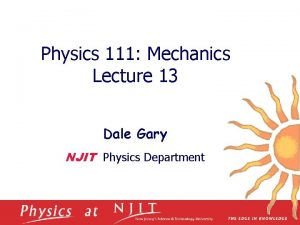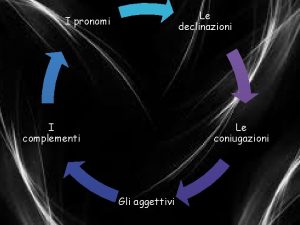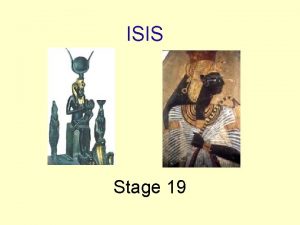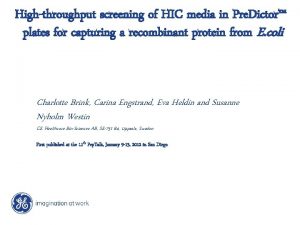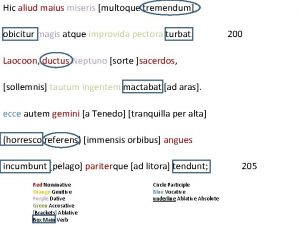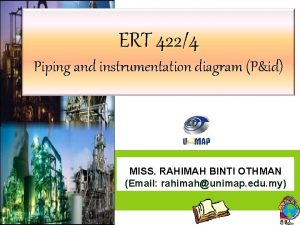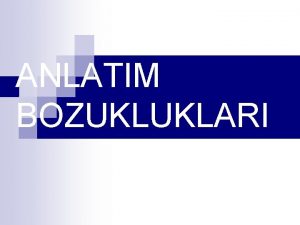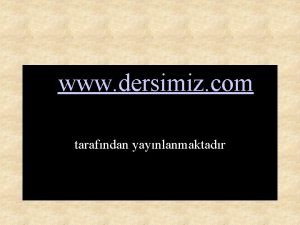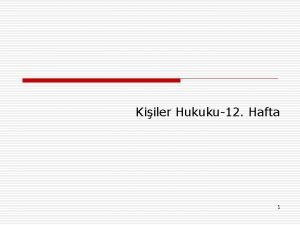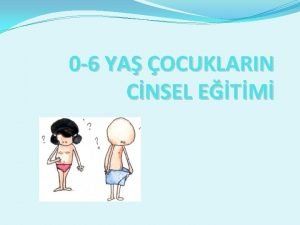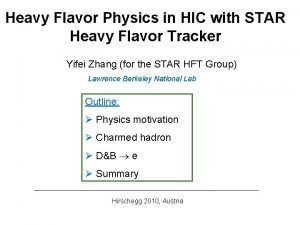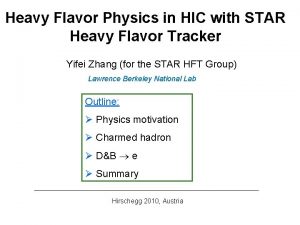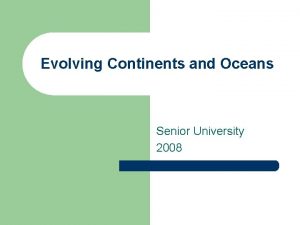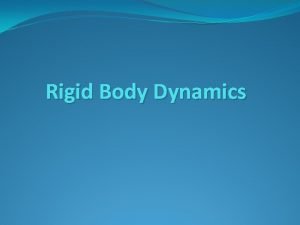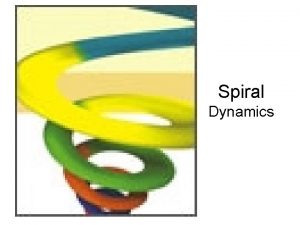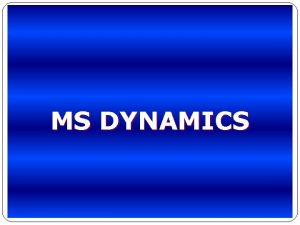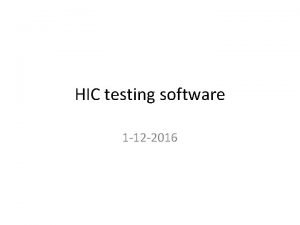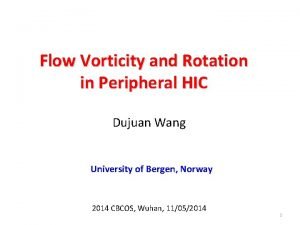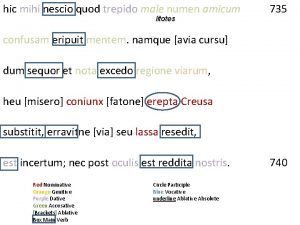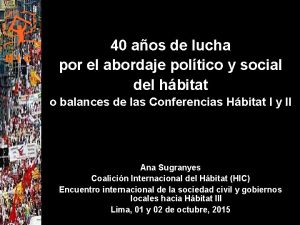Department of Physics HIC with Dynamics from Evolving










![Holographic renormalization Example: [Witten ‘ 98] • Quantifying the Conjecture <exp z=0∫O φ0>CFT = Holographic renormalization Example: [Witten ‘ 98] • Quantifying the Conjecture <exp z=0∫O φ0>CFT =](https://slidetodoc.com/presentation_image_h2/8431dd450955102477b25a378dd68669/image-11.jpg)

















- Slides: 28

Department of Physics HIC with Dynamics┴ from Evolving Geometries in Ad. S ar. Xiv: 1004. 3500 [hep-th], Anastasios Taliotis Partial Extension of ar. Xiv: 0805. 2927 [hep-th], ar. Xiv: 0902. 3046 [hep-th], ar. Xiv: 0705. 1234 [hep-ph] (published in JHEP and Phys. Rev. C) [ Albacete, Kovchegov, Taliotis] 1

Outline Motivating strongly coupled dynamics in HIC Ad. S/CFT: What we need for this work State/set up the problem Attacking the problem using Ad. S/CFT Predictions/comparisons/conclusions/Summary Future work 2

Motivating strongly coupled dynamics in HIC 3

Notation/Facts Proper time: Rapidity: Saturation scale valid for times t >> 1/Qs Bj QGP Hydro : The scale where density of partons becomes high. g<<1; valid up to times t ~ 1/QS. ØCGC describes matter distribution due to classical gluon fields and is rapidityindependent ( g<<1, early times). CGC ØHydro is a necessary condition for thermalization. Bjorken Hydro describes successfully particle spectra and spectral flow. Is g? ? >>1 at late times? ? Maybe; consistent with the small MFP implied by a hydro description. ØNo unified framework exists that describes both strongly & weakly coupled dynamics 4

Goal: Stress-Energy (SE) Tensor • SE of the produced medium gives useful information. • In particular, its form (as a function of space and time variables) allows to decide whether we could have thermalization i. e. it provides useful criteria for the (possible) formation of QGP. • SE tensor will be the main object of this talk: we will see how it can be calculated by non perturbative methods in HIC. 5

Most General Rapidity-Independent SE Tensor The most general rapidity-independent SE tensor for a collision of two transversely large nuclei is (at x 3 =0) which, due to gives ØWe will see three different regimes of p 3 6

I. Early times : τQs <<1 CGC II. Later times : τ>~1/Qs III. Much later times: τQs >>>1 Bjorken Hydrodynamics CGC 0 p(τ) Isotropization [Free streaming] thermalization [Lappi ’ 06 Fukushima ’ 07: p. QCD] [Talıotıs ’ 10: Ad. S/CFT] • Classical gluon fields • Hydrodynamic description • Pert. theory applies • Pert. Theory applies • Does pert. Theory apply? ? • Describes RHIC data well • Energy is conserved • Describes data successfully (particle multiplicity d. N/dn) [Krasnitz, Nara, Venogopalan, Lappi, Kharzeev, Levin, Nardi] (spectra d. N/d 2 p. Tdn for K, ρ, n & elliptic flow) [Heınz et al] 7

Bjorken Hydro & strongly coupled dynamics If then, as , one gets . Deviations from the energy conservation are due to longitudinal pressure, P 3 which does work P 3 d. V in the longitudinal direction modifying the energy density scaling with tau. §It is suggested that neither classical nor quantum gluonic or fermionic fields can cause the transition from free streaming to Bjorken hydro within perturbation theory. [Kovchegov’ 05] §On the other hand Bjorken hydro describe simulations satisfactory. §Conclude that alternative methods are needed! 8

Ad. S/CFT: What we need for this work 9

Quantifying the Conjecture <exp z=0∫O φ0>CFT = Zs(φ|φ(z=0)= φo) O is the CFT operator. Typically want <O 1 O 2…On> φ0 =φ0 (x 1, x 2, … , xd) is the source of O in the CFT picture φ =φ (x 1, x 2, … , xd , z) is some field in string theory with B. C. φ (z=0)= φ0 10
![Holographic renormalization Example Witten 98 Quantifying the Conjecture exp z0O φ0CFT Holographic renormalization Example: [Witten ‘ 98] • Quantifying the Conjecture <exp z=0∫O φ0>CFT =](https://slidetodoc.com/presentation_image_h2/8431dd450955102477b25a378dd68669/image-11.jpg)
Holographic renormalization Example: [Witten ‘ 98] • Quantifying the Conjecture <exp z=0∫O φ0>CFT = Zs(φ|φ(z=0)= φo) • Know the SE Tensor of Gauge theory is given by • So gμν acts as a source => in order to calculate Tμν from Ad. S/CFT must find the metric. Metric has its eq. of motion i. e. Einsteins equations. 11

Holographic renormalization de Haro, Skenderis, Solodukhin ‘ 00 § Energy-momentum tensor is dual to the metric in Ad. S. Using Fefferman-Graham coordinates one can write the metric as with z the 5 th dimension variable and § Expand § Using Ad. S/CFT can show: the 4 d metric. near the boundary (z=0) of the Ad. S space: , and 12

State/set up the problem 13

Strategy Initial Tµν phenomenology Initial Geometry Dynamical Tµν (our result) Evolve Einstein's Eq. Ad. S/CFT Dictionary Dynamical Geometry 14

Field equations, Ad. S 5 shockwave; ∂g. MN Tμν Ø Eq. of Motion (units L=1) for gΜΝ(x. M = x±, x 1, x 2, z) is generally given Ø Ad. S-shockwave with bulk matter: [Janik & Peschanski ’ 06] Then ~z 4 coef. implies <Tμν (xμ)> ~ -δμ + δν + µlog(r 1) δ(x+) in QFT side Corresponding bulk tensor JMN : 15

Single nucleus Single shockwave The picture in 4 d is that matter moves ultrarelativistically along x- according to figure. Einstein's equations are satisfied trivially except (++) component; it satisfies a linear equation: □(z 4 t 1)=J++ This suggests may represent the shockwave metric as a single vertex: a graviton exchange between the source J++ (the nucleus living at z=0; the boundary of Ad. S) and point XM in the bulk which gravitational field is measured. 16

4 D Picture of Collision 17

Superposition of two shockwaves Non linearities of gravity ? Flat Ad. S One graviton ex. Higher graviton ex. 18 Due to non linearities

Back-to-Back reactions for JMN • In order to have a consistent expansion in µ 2 we must determine • We use geodesic analysis • Bulk source J++ (J--) moves in the gravitational filed of the shock t 1(t 2) • Important: is conserved iff b≠ 0 Self corrections to JMN 19

Calculation/results • Step 1: Choose a gauge: Fefferman-Graham coordinates • Step 2: Linearize field eq. expanding around 1/z 2 ηMN (partial DE with w. r. t. x+, x-, z with non constant coef. ). • Step 3: Decouple the DE. In particular all components g(2)µν obey: □g(2)µν = A(2)µν(t 1(x-) , t 2 (x+) , J) with box the d'Alembertian in Ad. S 5. • Step 4: Solve them imposing (BC) causality-Determine the GR • Step 5: Determine Tμν by reading the z 4 coef. of gμν ü Side Remark: Gzz encodes tracelessness of Tµν Gzν encode conservation of Tµν 20

The Formula for Tµν 21

Eccentricity-Momentum Anisotropy εx= εx(x) (left) and εx= εx(1/x) (right) for intermediate. Agrees qualitatively with [Heinz, Kolb, Lappi, Venugopalan, Jas, Mrowczynski] 22

Conclusions • Built perturbative expansion of dual geometry to determine Tµν ; applies for sufficiently early times: µτ3<<1. • Tµν evolves according to causality in an intuitive way! There is a kinematical window where is invariant under . [Gubser ‘ 10] • Our exact formula (when applicable) allows as to compute Spatial Eccentricity and Momentum Anisotropy. 23

• When τ>>r 1 , r 2 have ε~τ2 log 2 τ-compare with ε~Q 2 slog 2 τ [Lappi, Fukushima] • Despite J being localized, it still contributes to gµν and so to Tµν not only on the light-cone but also inside. • Impact parameter is required otherwise violate conservation of JMN and divergences of gµν. Not a surprise for classical field theories. • Our technique has been applied to ordinary (4 d) gravity and found MS thesis. dept. similar behavior for gµν. Taliotis’ 10 of Mathematics, OSU • A phenomenological model using the (boosted) Woods-Saxon profile: [Gubser, Yarom, Pufu ‘ 08] Note symmetry under when b=0; [Gubser’ 10] For τ> r 1, r 2

Thank you 25

Supporting slides 26

O(µ 2) Corrections to Jµν Remark: These corrections live on the forward light-cone as should! 27

Field Equations 28
 Hic, haec, hoc
Hic, haec, hoc Evolving design
Evolving design A framework for clustering evolving data streams
A framework for clustering evolving data streams Key evolving signature
Key evolving signature Evolving
Evolving Princeton
Princeton Physics 121 njit
Physics 121 njit Department of physics university of tokyo
Department of physics university of tokyo Warwick astro
Warwick astro Bhu physics department
Bhu physics department Iit kanpur physics faculty
Iit kanpur physics faculty Kepler 4 njit
Kepler 4 njit Michigan state physics
Michigan state physics Modern physics vs classical physics
Modern physics vs classical physics University physics with modern physics fifteenth edition
University physics with modern physics fifteenth edition Physics ia ideas
Physics ia ideas Complemento di vocazione
Complemento di vocazione Hic vir est aristo
Hic vir est aristo Hic media
Hic media Hic aliud maius miseris multoque tremendum
Hic aliud maius miseris multoque tremendum P&id fc
P&id fc Hic haec hoc ille illa illud
Hic haec hoc ille illa illud Ekşi yiyecekleri az acıyı ise hiç yemezdi
Ekşi yiyecekleri az acıyı ise hiç yemezdi Sayılardan sonra sıra bildirmek için
Sayılardan sonra sıra bildirmek için Is ea id chart
Is ea id chart Sınırlı ehliyetsiz tek başına yapabileceği işlemler
Sınırlı ehliyetsiz tek başına yapabileceği işlemler Is kenya an lic
Is kenya an lic çocuğum hiç soru sormuyor
çocuğum hiç soru sormuyor Quante declinazioni ci sono in latino
Quante declinazioni ci sono in latino
